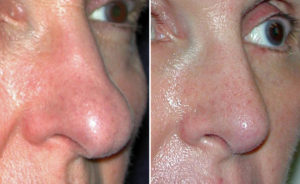
Every rhinoplasty patient will have a dressing on the nose after surgery. This consists of tapes and a splint on top of them covering most of the nose except the nostrils. The sole purpose of this type of nasal dressing is to keep the swelling on the nose down and help the skin to stick back down to the reshaped cartilage and bone framework. While it will not get eliminate all the swelling, it helps considerably. It will be removed in a week but it is very important to have the ‘visible sign of having a nose job’ in place after surgery. When it is removed, you should see some of the positive changes but far from the final results which takes many months.
Bruising after a rhinoplasty will depend on whether the nasal bones (i.e., nasal osteotomies) were broken as part of the procedure. Most full rhinoplasties will have reshaped bone and cartilage and the bone cutting and narrowing will result in bruising developing under the eyes. (raccoon eyes). Usually, it takes several days for the bruising to be fully seen and ten to fourteen days until it goes away completely. If no bone cutting is done, bruising will not usually develop.
Numbness over the nose, particularly on the skin of the tip of the nose, is common. Raising up the skin to work on the tip of the nose cuts the tiny little nerves to the skin making it numb for several months. The feeling will eventually come back as these nerves regrow back into the skin but it will be at least 3 months or more until it all comes back.
The tip of the nose will usually feel very stiff after surgery. This is expected and desired for best long-term results. Even though the tip of the nose may have been reshaped, it is strengthened through cartilage grafts and suture techniques to prevent weakening over time as the nose heals. This support method makes the nose feel very stiff initially. The ‘springiness’ in the nose will usually come back, or at least get softer, by one year after surgery.
Stuffiness in the nose, or difficulty in breathing, may not occur after all rhinoplasties. When the inside of the nose is worked on (septoplasty, turbinate reductions), considerable stuffiness will exist after surgery. Blood clots in the nose and impaired nasal breathing will be present for several weeks before it starts to improve. It can take up to four to six weeks after surgery until real nasal breathing improvement is felt. If the rhinoplasty work is restricted just to the visible portions of the nose, congestion and breathing difficulties will not occur.
Dr. Barry Eppley
Indianapolis, Indiana


